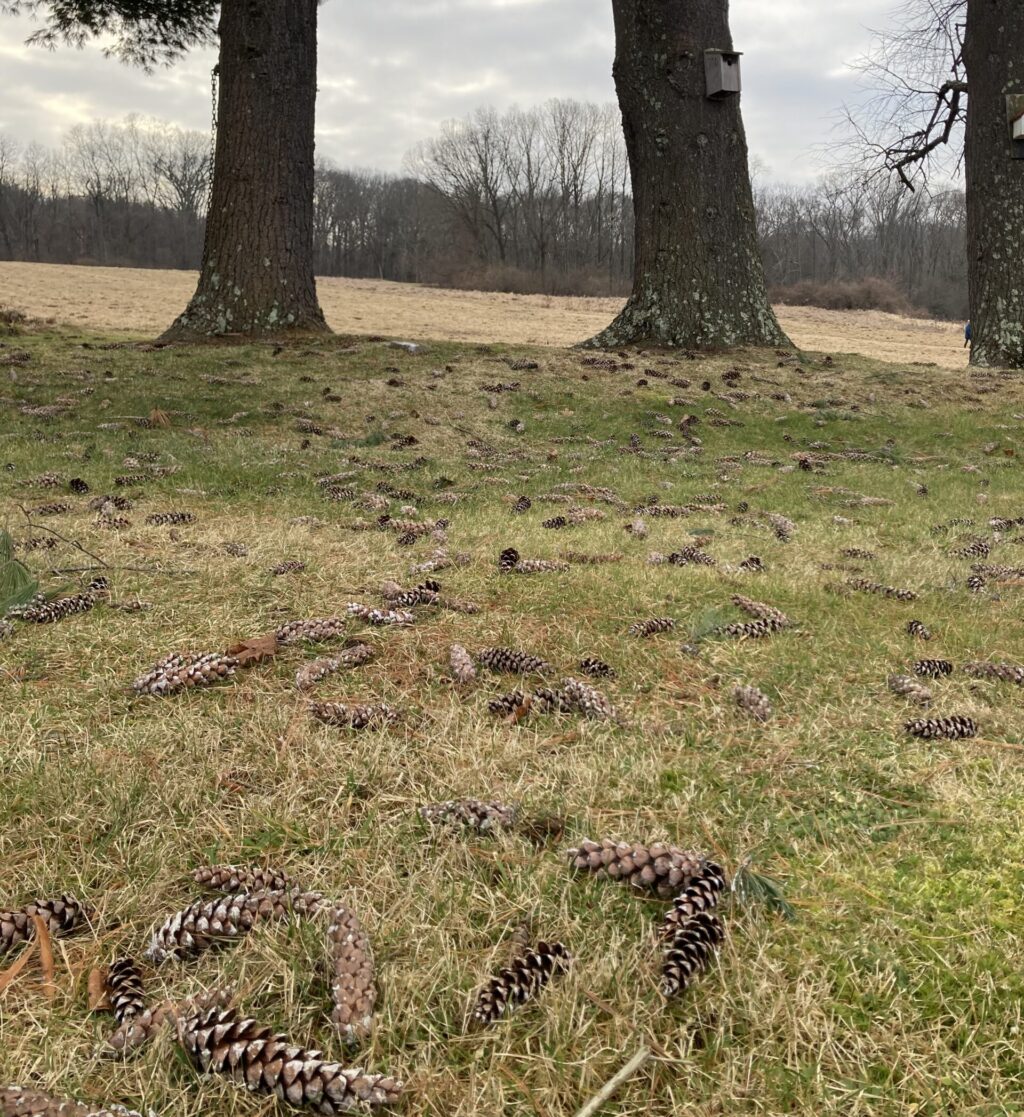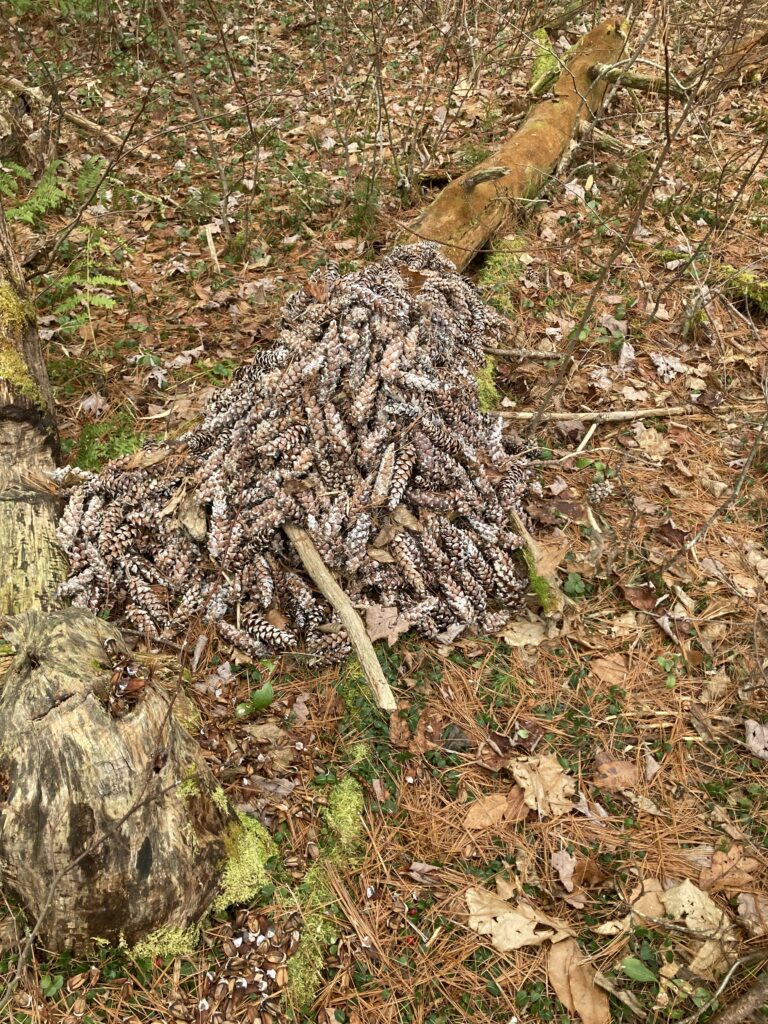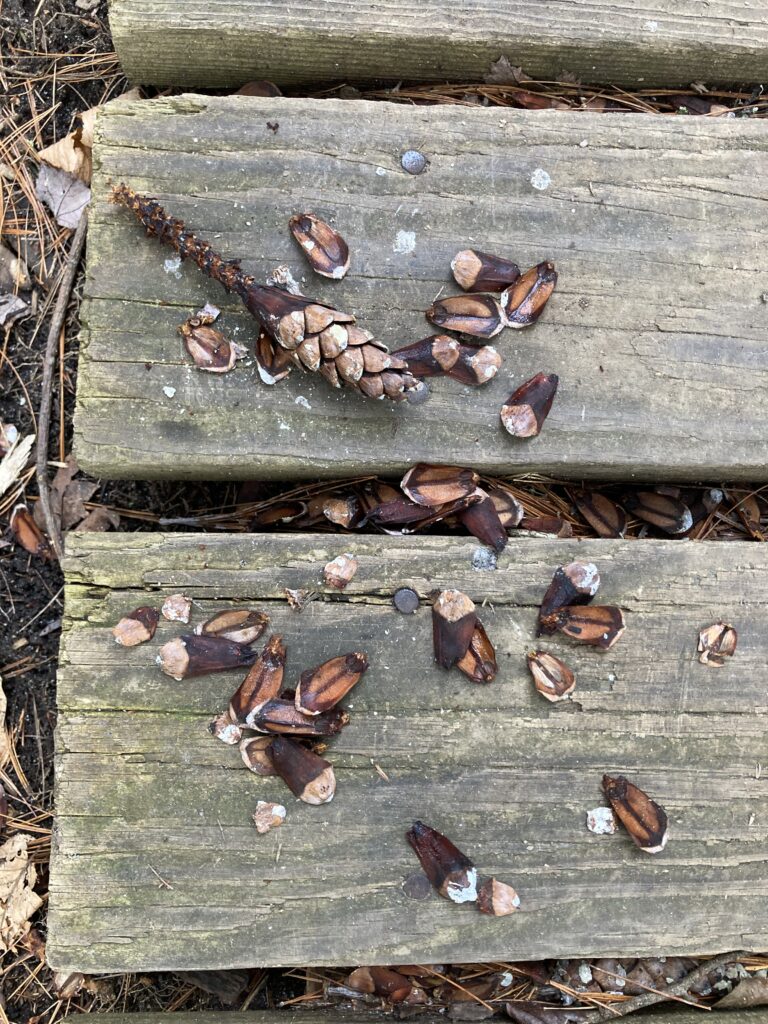Almanac: Woody Fruit

White pine cones have been unusually abundant this fall and winter, covering trails and lawns, such as this one in north Amherst. Photo: Stephen Braun
For about two months now I’ve been puzzling about how to make pine cones interesting. Specifically, the cones of our most dominant and majestic local conifer, white pine trees. I’m not sure it’s possible, but I’m going to give it a shot and let you, gentle reader, be the judge.
It all began back in early December when a group of friends and I were hiking in woods north of the Quabbin reservoir. We were bushwhacking, which is the best way to come upon interesting or surprising things in the woods because most sane people stick to trails. We came upon some impressive piles of white pine cones…some with only a few dozen cones, others, such as the one below, with hundreds of cones, neatly stacked near the trunks of old white pines that soared overhead.

The only possible culprits behind these mounds are red squirrels, those frenetic cousins of the more familiar (and urban) grey squirrels, which will loudly scold you (from a safe distance of course) if you come close to a tree or area they consider theirs. Red squirrels are well-known for their habit of stashing pine cones for future use, especially green cones that haven’t already opened and dropped their seeds.
It’s said that one squirrel can stash over 10,000 cones in a single year. Such stashes are called middens, and they are typically either buried or piled into some kind of crevice, small cave, or other area that is at least somewhat protected from the weather and other animals seeking the oil-rich pine cone seeds. The piles we found were peculiar for two reasons: they were out in the open (I have never seen such piles in all my years of tramping around this region) and the cones themselves were not green…they were open, with the two little seeds at the base of each pine cone scale intact. Why would a squirrel go to such effort to create a pile of food that might as well have a sign on it saying “Eat me”?
Back home I did some poking around for an answer, but didn’t find much of anything that would explain it. So I set the matter aside (and didn’t write anything about it because, well…it didn’t seem very satisfying to present a mystery without an answer).
In the weeks after that discovery, however, as snows came and went and I was out and about in boots or on skis, I noticed that white pine cones seemed to be unusually thick on forest floors and even in my own backyard, courtesy of some tall trees in my neighbors’ yards. The cones have been dropping all winter, it seems, and just the other day on a hike with a friend our boots crunched over a thick carpet of white pine cones covering the trail at Eastman Brook.
In talking with others over the past couple of months, some of whom are naturalists with more knowledge than I about the region’s forests, it has become clear that we are at the tail end of a mast year for white pine cones, at least in central Massachusetts. The word “mast,” in this sense, means an unusual abundance of tree fruit or seeds, the word being derived from the old English word “maest” that referred to an accumulation of nuts on the ground under a tree that were gathered and fed to farm animals such as pigs. Many trees, including oaks, walnuts, beech, and hickory, will have mast years from time to time.
The trigger for mast years appears to be stress during the time the nuts or seeds are developing. In our area, stress is usually in the form of drought or infestation…both of which impair the metabolic machinery that sustain the trees and provide the energy needed for them to reproduce. Fruit trees sometimes bear their heaviest fruits just before they succumb to an infestation or disease. White pine cones take two years to mature, so it would have been the weather at the end of 2021 or spring of 2022 that stimulated the abundant production of cones we’re seeing now.
I think the reality of a mast year for white pine cones may explain the piles we saw back in December. My theory is that the squirrels were simply overwhelmed by the embarrassment of riches raining down from above, so they just piled up the cones wherever they could, without bothering to do a more careful or stealthy job. I’ve tried to ask the squirrels about this, but for some reason they just look at me as though I’m mad and continue their chattering. I find this mildly annoying because I can clearly understand what they are saying (i.e., get the heck outta here) so why can’t they understand what I’m saying?
Has this been interesting yet? I hope so, but in case you’re yawning, I’ll toss in something else about pine cones that might perk you up. I probably should have known about this curious factoid already, but for some reason it escaped my awareness until I read about it in the course of looking into the pine cone pile mystery, namely that pine cones have genders. Pine trees produce male and female cones, each playing a distinct role in the reproductive cycle. Male cones, often small and inconspicuous, produce pollen, the fine powder that is released so abundantly in spring that sometimes you can see what looks like a pale green smoke wafting through the forest on a windy day. The wind carries the pollen to the female cones, preferably, but not certainly, on a different tree (the better to introduce genetic variation). The female cones are larger and contain ovules, which, when pollinated, produce the seeds that are enclosed in the woody, scaly covering that I’ve always assumed are the only kinds of pine cones. The cones, in other words, are actually a kind of fruit, the cones’ scales being analogous to the rind of a watermelon or—perhaps more fittingly—the cob of an ear of corn.
Red squirrels are geniuses at efficiently finding and eating the seeds in white pine cones. They will sit up, grasping a cone with both hands, and methodically clip off a scale, eat the seed, drop the scale, rotate the cone a smidge, clip off the next scale, etc. You can find partially or wholly-stripped pine cone “cobs” all over the place these days, along with the piles of discarded scales.

OK, that’s all I got. It’s been a fun column to write…hope you enjoyed it. And if you’ve got any experiences with our current white pine mast year that you’d like to share, post it below! It’ll help me think I’m not a little nuts to find pine cones so interesting.
Almanac is a regular Indy column of observations, musings, and occasional harangues related to the woods, waters, mountains, and skies of the Pioneer Valley. Please feel free to comment on posts and add your own experiences or observations.

I love pine cones too! Thanks for writing about them, and of course the squirrels. I never knew what the cause was when a tree drops mass amounts either, ive seen it with our blue spruce pines,and oak trees.
Interesting? Fascinating!
Next time you visit Pisa, just walk from the little airport to the center of the city. You follow small city streets lined with many pine trees: welcome to the land of pine nuts:
https://en.wikipedia.org/wiki/Stone_pine
But human-edible pine nuts aren’t limited to Europe, there are also those of the North American piñon pines:
https://en.wikipedia.org/wiki/Pinyon_pine
I’ve never tasted the nuts of the white pine, but hope to ask SB if he has (next time I see him, perhaps later today?)!
Maybe they can be ground into flour and combined with maple syrup for an all-American trail mix? 😉
Thank you for this column, Steve. I was just marveling at the bumper crop of white pine cones in my yard and am glad to have the mystery solved with so little effort on my part. Please keep this articles coming!